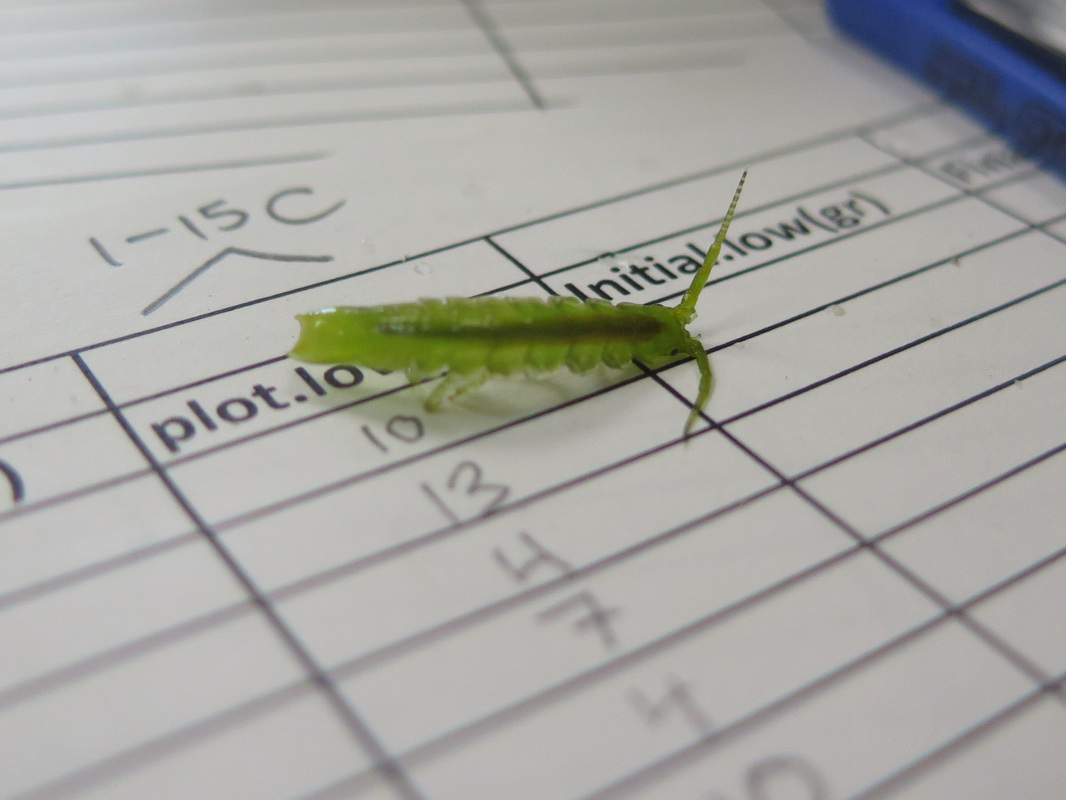Eelgrass isopod, concave isopod, cut-tailed isopod • Idotea resecata, Pentidotea resecata

Photo by Angeleen Olson.
Identification
This isopod's elongated, segmented body ends with a concave tip (at the posterior end of the telson). This is a distinctive feature for this species. Its colouring is green to brownish-green: individuals living on eelgrass (Zostera spp.) are more green, while those living on kelp are more brown. Males often have a stripe down their back. This species grows to 4 cm long.
Habitat & Range
True to its name, the eelgrass isopod can be found clinging lengthwise along pieces of eelgrass. It can also be found on kelp (particularly Macrocystis). In addition to providing shelter and camouflage, eelgrass and kelp are also consumed as food by the eelgrass isopod. This isopod inhabits the intertidal and subtidal to 19 m deep, and ranges from central Alaska to northern Mexico.
Similar Species
The eelgrass isopod is thinner than the kelp isopod (Idotea wosnesenskii). The latter also lacks the concave posterior tip.
Intriguing Info
When dislodged from its chosen substrate this species displays excellent swimming abilities.
iNaturalist
https://www.inaturalist.org/taxa/261239-Idotea-resecata
This isopod's elongated, segmented body ends with a concave tip (at the posterior end of the telson). This is a distinctive feature for this species. Its colouring is green to brownish-green: individuals living on eelgrass (Zostera spp.) are more green, while those living on kelp are more brown. Males often have a stripe down their back. This species grows to 4 cm long.
Habitat & Range
True to its name, the eelgrass isopod can be found clinging lengthwise along pieces of eelgrass. It can also be found on kelp (particularly Macrocystis). In addition to providing shelter and camouflage, eelgrass and kelp are also consumed as food by the eelgrass isopod. This isopod inhabits the intertidal and subtidal to 19 m deep, and ranges from central Alaska to northern Mexico.
Similar Species
The eelgrass isopod is thinner than the kelp isopod (Idotea wosnesenskii). The latter also lacks the concave posterior tip.
Intriguing Info
When dislodged from its chosen substrate this species displays excellent swimming abilities.
iNaturalist
https://www.inaturalist.org/taxa/261239-Idotea-resecata
References
Lamb, A., and Hanby, B. (2005). Marine Life of the Pacific Northwest [electronic version]. Madeira Park, BC: Harbour Publishing.
Leno, H., Helmstetler, H., and Cowles, D. (2012). Pentidotea resecata (Stimpson, 1857). Invertebrates of the Salish Sea. Rosario Beach Marine Laboratory. Accessed 27/05/2016.
Authors and editors of page
Kelly Fretwell (2016).
Lamb, A., and Hanby, B. (2005). Marine Life of the Pacific Northwest [electronic version]. Madeira Park, BC: Harbour Publishing.
Leno, H., Helmstetler, H., and Cowles, D. (2012). Pentidotea resecata (Stimpson, 1857). Invertebrates of the Salish Sea. Rosario Beach Marine Laboratory. Accessed 27/05/2016.
Authors and editors of page
Kelly Fretwell (2016).




